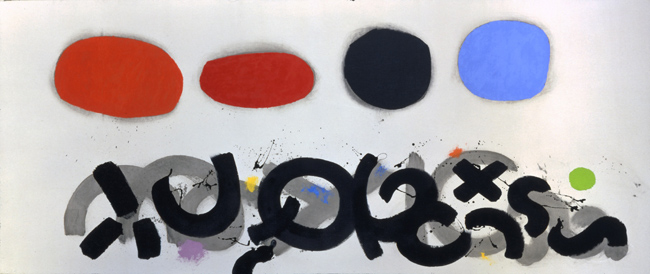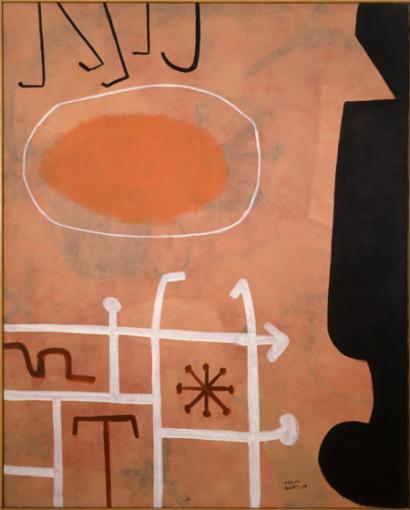Like those previously dedicated to William Baziotes and Richard Pousette-Dart at the Peggy Guggenheim Collection, this exhibition brings to Italy a better understanding of a generation of New York artists that in the 1950s came to form American Abstract Expressionism. The origins of this movement in the 1940s is closely linked to the career of Peggy Guggenheim herself, and to her New York museum-gallery Art of This Century. The exhibition has been organized in partnership with the Adolph and Esther Gottlieb Foundation, New York, which has lent numerous paintings and sculptures. It also benefits from loans from the Museum Frieder Burda, Baden-Baden, the Solomon R. Guggenheim Museum, New York, the Musée national d’art moderne, Paris, the American Contemporary Art Gallery, Munich, and from several private collectors.
Leading the “Irascibles”
The career of Adolph Gottlieb (1903-1974), charismatic artist and thinker, is closely tied to that of other exponents of American Abstract Expressionism: from the early 1930s he had firm friendships with Barnett Newman and Mark Rothko.. In 1941 Gottlieb and Rothko together resolved to explore mythical and Jungian subject matter, thus signalling for the first time an avant-garde that was independent of European prototypes. With Rothko, Gottlieb was the author of the historic letter to The New York Times of 13 June 1943, the first public statement of theories underlying what was later to be known as American Abstract Expressionism. In spring 1950 he organized a group of artists to protest the position of the Metropolitan Museum of Art towards contemporary American art. The group was labeled ‘The Irascibles’ by an article in The New York Herald Tribune, and presented to a much larger public through an iconic photograph (including Baziotes, de Kooning, Motherwell, Newman, Pollock, Pousette-Dart, Clyfford Still and Gottlieb) by Nina Leen published in Life magazine. In 1958-59, a touring exhibition of the Museum of Modern Art, that included Gottlieb and several of these same artists, was titled The New American Painting.
Working with a grid
As Sanford Hirsch, Executive Director of the Adolph and Esther Gottlieb Foundation, notes in the catalogue: “Gottlieb is labeled an Abstract Expressionist painter (…). However, the term itself is too narrow to comprehend the breadth of Gottlieb’s art and its impact on his colleagues, audiences, and the art that would follow.” The exhibition reveals the diversity of Gottlieb’s production, and its ceaseless evolution, according to his own aphorism: “Different times require different images.” It opens with paintings, drawings and etchings from the 1930s, including portraits of Rothko and another close friend Milton Avery, as well as allusions to an important sojourn in Arizona in 1937-38. Next comes a numerous selection, for the first time in Italy, of the first cohesive series of Gottlieb’s paintings, the Pictographs, begun in 1941, the year of Pearl Harbor and America’s entry to World War II. These place Gottlieb, alongside Rothko and a few others such as Arshile Gorky and Pollock, among the pioneers of the new American avant-garde. Typically a grid segments the picture surface; inside its compartments Gottlieb placed symbols, whether a hand, an eye, or hieroglyphs of his own invention that blend American Indian or other primitive ritual imagery with allusions to Greek mythology.
A growing critical success
Having exhausted the visual possibilities of the Pictograph, Gottlieb developed novel compositional types such as the Labyrinths (beginning with Labyrinth #1, 1950, in the exhibition) and Imaginary Landscapes from 1951, such as Sea and Tide (1952, in the exhibition). These works coincide with Gottlieb’s growing commercial and critical success in the mid 1950s. In 1956, the lower part of the Imaginary Landscapes detached itself from the picture edges to become an independent floating form in vertical compositions known as the Bursts, Gottlieb’s best known works. A jury headed by Italian critic and historian Giulio Carlo Argan awarded Gottlieb first prize at the 1963 São Paulo Biennial. In the 1960s, notwithstanding the emergence of Pop Art, antithesis of Abstract Expressionism, Gottlieb’s painting was perceived as a prophetic and vital source of Minimal art. The exhibition also includes a selection of Gottlieb’s sculptures, made from colored cardboard and presented in the company of the cosmic images that inspired them. The exhibition closes with a series of late works in which the explosive Burst contracts into more geometric and cooler discs, painted in the years prior to his death.
PUBLICATION:
The exhibition is accompanied by a fully illustrated catalogue published by Giunti Editore, in English and Italian. The catalogue includes essays by Luca Massimo Barbero, Associate Curator of the Peggy Guggenheim Collection, and by Pepe Karmel, Associate Professor and Chair in the Department of Fine Arts, New York University
 Imaginary Landscape, 1969 Oil on canvas 121.9 x 284.5 cm Collection of the Adolph and Esther Gottlieb Foundation, New York ©Adolph and Esther Gottlieb Foundation / Licensed by ©Adolph and Esther Gottlieb Foundation / Licensed by VAGA, NY / by SIAE 2010
To see more illustrations, click on VERSION FRANCAISE at the top
of this page
|









